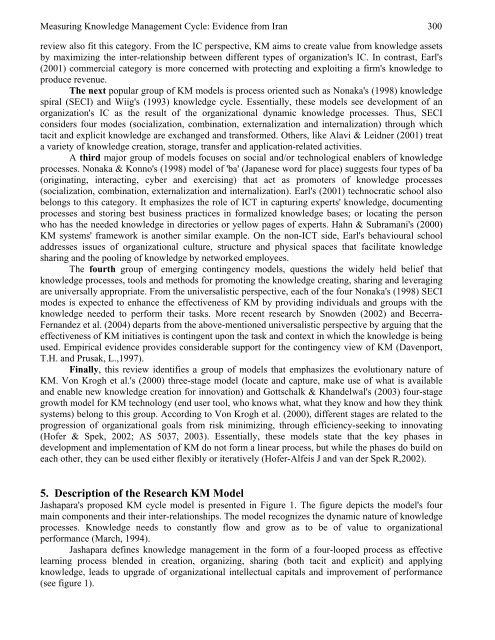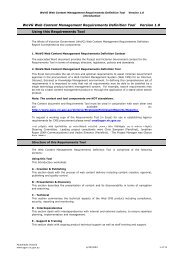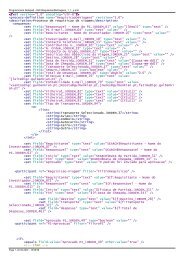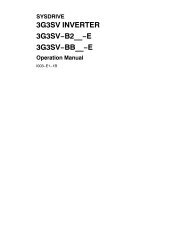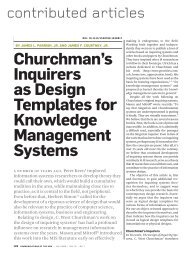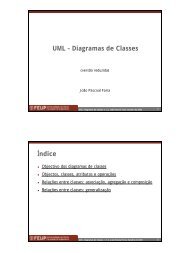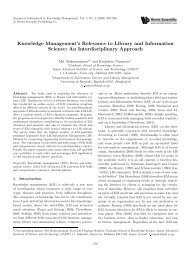Measuring Knowledge Management Cycle: Evidence from Iran
Measuring Knowledge Management Cycle: Evidence from Iran
Measuring Knowledge Management Cycle: Evidence from Iran
- No tags were found...
Create successful ePaper yourself
Turn your PDF publications into a flip-book with our unique Google optimized e-Paper software.
<strong>Measuring</strong> <strong>Knowledge</strong> <strong>Management</strong> <strong>Cycle</strong>: <strong>Evidence</strong> <strong>from</strong> <strong>Iran</strong> 300review also fit this category. From the IC perspective, KM aims to create value <strong>from</strong> knowledge assetsby maximizing the inter-relationship between different types of organization's IC. In contrast, Earl's(2001) commercial category is more concerned with protecting and exploiting a firm's knowledge toproduce revenue.The next popular group of KM models is process oriented such as Nonaka's (1998) knowledgespiral (SECI) and Wiig's (1993) knowledge cycle. Essentially, these models see development of anorganization's IC as the result of the organizational dynamic knowledge processes. Thus, SECIconsiders four modes (socialization, combination, externalization and internalization) through whichtacit and explicit knowledge are exchanged and transformed. Others, like Alavi & Leidner (2001) treata variety of knowledge creation, storage, transfer and application-related activities.A third major group of models focuses on social and/or technological enablers of knowledgeprocesses. Nonaka & Konno's (1998) model of 'ba' (Japanese word for place) suggests four types of ba(originating, interacting, cyber and exercising) that act as promoters of knowledge processes(socialization, combination, externalization and internalization). Earl's (2001) technocratic school alsobelongs to this category. It emphasizes the role of ICT in capturing experts' knowledge, documentingprocesses and storing best business practices in formalized knowledge bases; or locating the personwho has the needed knowledge in directories or yellow pages of experts. Hahn & Subramani's (2000)KM systems' framework is another similar example. On the non-ICT side, Earl's behavioural schooladdresses issues of organizational culture, structure and physical spaces that facilitate knowledgesharing and the pooling of knowledge by networked employees.The fourth group of emerging contingency models, questions the widely held belief thatknowledge processes, tools and methods for promoting the knowledge creating, sharing and leveragingare universally appropriate. From the universalistic perspective, each of the four Nonaka's (1998) SECImodes is expected to enhance the effectiveness of KM by providing individuals and groups with theknowledge needed to perform their tasks. More recent research by Snowden (2002) and Becerra-Fernandez et al. (2004) departs <strong>from</strong> the above-mentioned universalistic perspective by arguing that theeffectiveness of KM initiatives is contingent upon the task and context in which the knowledge is beingused. Empirical evidence provides considerable support for the contingency view of KM (Davenport,T.H. and Prusak, L.,1997).Finally, this review identifies a group of models that emphasizes the evolutionary nature ofKM. Von Krogh et al.'s (2000) three-stage model (locate and capture, make use of what is availableand enable new knowledge creation for innovation) and Gottschalk & Khandelwal's (2003) four-stagegrowth model for KM technology (end user tool, who knows what, what they know and how they thinksystems) belong to this group. According to Von Krogh et al. (2000), different stages are related to theprogression of organizational goals <strong>from</strong> risk minimizing, through efficiency-seeking to innovating(Hofer & Spek, 2002; AS 5037, 2003). Essentially, these models state that the key phases indevelopment and implementation of KM do not form a linear process, but while the phases do build oneach other, they can be used either flexibly or iteratively (Hofer-Alfeis J and van der Spek R,2002).5. Description of the Research KM ModelJashapara's proposed KM cycle model is presented in Figure 1. The figure depicts the model's fourmain components and their inter-relationships. The model recognizes the dynamic nature of knowledgeprocesses. <strong>Knowledge</strong> needs to constantly flow and grow as to be of value to organizationalperformance (March, 1994).Jashapara defines knowledge management in the form of a four-looped process as effectivelearning process blended in creation, organizing, sharing (both tacit and explicit) and applyingknowledge, leads to upgrade of organizational intellectual capitals and improvement of performance(see figure 1).


